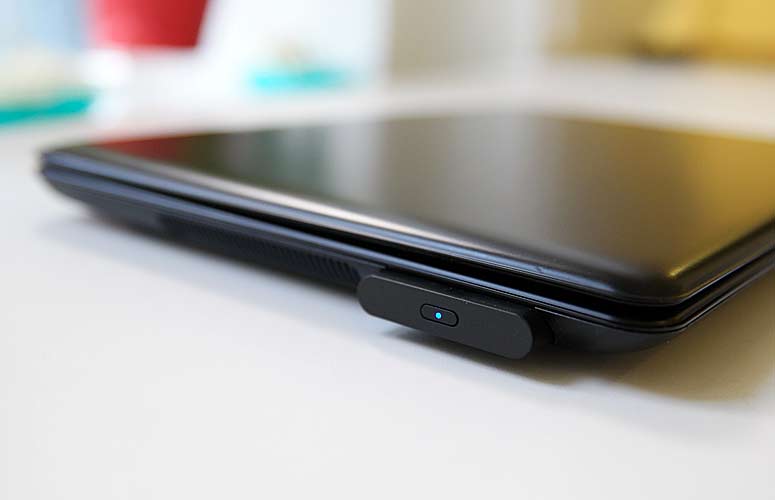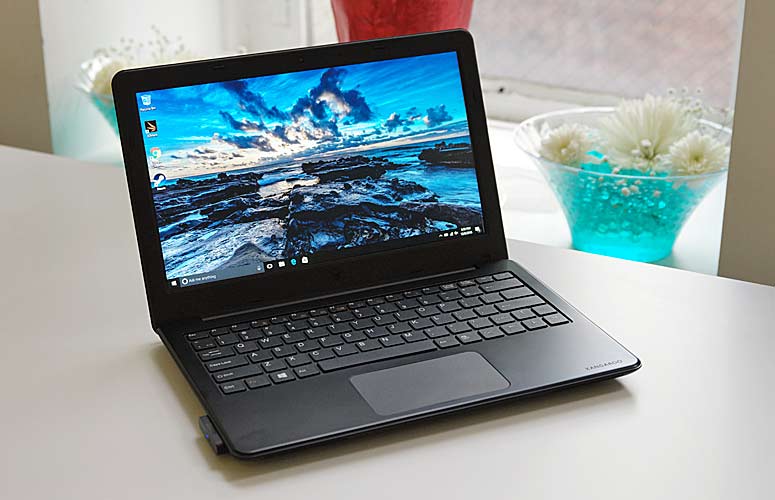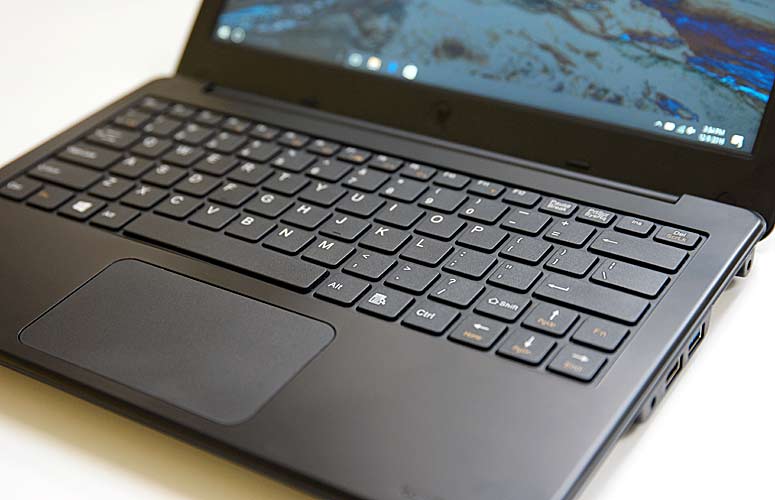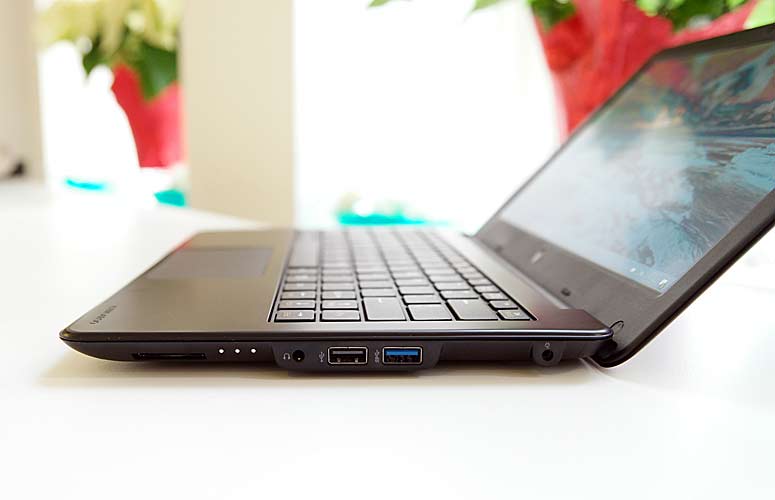Laptop Mag Verdict
The Kangaroo Notebook is a dock with two computing modules, but the laptop has a horrible keyboard and touchpad, and it has worse battery life than the competition. Avoid it.
Pros
- +
Passable display, decent performance
- +
Little bloatware
Cons
- -
Feels cheap
- -
Horrible keyboard and touchpad
- -
Muffled sound
- -
Runs hot
- -
Less battery life than the competition
Why you can trust Laptop Mag
With all of our connected gadgets, it seems harder than ever to separate our work and personal lives. The $300 Kangaroo Notebook makes an attempt to solve this problem by splitting the system into two less-powerful computers. The laptop uses two modules, and each has its own processor, RAM and storage.
In theory, you would use them to create separate work and family laptops, personal and family notebooks, or any other way you want to divide it (maybe you're hiding something from your spouse!). But the laptop part is junk: It feels cheap, and it has a bad touchpad and an even worse keyboard. It also suffers from short battery life. It has passable performance and a decent display, but the other problems prevent us from recommending it to anyone.
Design
It wouldn't surprise me to see the Kangaroo Notebook sold in a toy store rather than by a tech retailer. It's made of three parts: a laptop dock and two modules that do the actual computing, and it all feels low grade. The laptop's lid is made of black, fingerprint-attracting plastic and is marked only with Kangaroo's logo in the upper right-hand corner. When I lifted the lid, I was greeted with a 1366 x 768 display, island-style keyboard and a deck made of more plastic.
The computing module, which is called the Kangaroo Mini, holds the processor, RAM and storage. It's a gray box about the size of a large pack of gum. The Mini plugs into a proprietary port on the left side of the laptop dock. But since it doesn't lie flush, it makes a small-but-unseemly bulge that sticks out from the side of the notebook. The power button is located on the edge of the module, and it's frustratingly flat. I had to dig the side of my fingernail into the button every time I wanted to turn the laptop on. It wasn't a pleasant experience.
At 2.6 pounds and 11.4 x 7.7 x 0.4 inches, the Kangaroo is about the same size as competing 11-inch laptops, but slightly heavier. The Dell Inspiron 11 3000 is 2.4 pounds and 11.5 x 7.7 x 0.7 inches, and the Lenovo Ideapad 100S is 2.2 pounds and 11.5 x 8 x 0.7 inches.
MORE: Best Laptops Under $500
Sign up to receive The Snapshot, a free special dispatch from Laptop Mag, in your inbox.
Besides the proprietary port for the Kangaroo Mini, which is located on the left of the laptop, you'll find a headphone jack, SD card reader, a USB 2.0 port and a USB 3.0 port on the right.
Modules
The Notebook comes with two Kangaroo Mini modules that have identical specs. Each has a 1.44-GHz Intel Atom x5-Z8350 processor, 2GB of RAM and 32GB of storage. The idea is that you can use one module as your personal computer and the other for family or business purposes, which allows you to keep work and play separate.
The best-use case I could think of is if two people in a family want to share a notebook, but even that falls flat. What happens when they want to use the laptop at the same time? You can't, so this is limited to just one person or to those who love to share. There's also no way to use the modules without plugging them into the laptop, so forget about attaching one to your monitor and employing it as a desktop.
Display
The display on the Kangaroo is fairly average for a low-cost, 11-inch notebook. It's usable, but the colors aren't eye-popping. I watched the trailer for Guardians of the Galaxy Vol. 2, and the explosions during a spaceship dogfight appeared bright white, instead of yellow and a crisp orange.
Covering just 70 percent of the sRGB color gamut, the screen isn't the most vivid. The average ultraportable reproduces 97 percent, though competitors like the Ideapad 100S (62 percent) and Inspiron (65 percent) offered slightly duller hues.
The screen measured 246 nits of brightness in our lab, falling short of the category average (304 nits) and again beating the Inspiron (193 nits) and Ideapad (243 nits). Despite the below-average brightness, I found it usable for everyday tasks like web browsing.
Keyboard and Touchpad
The keyboard on the Kangaroo Notebook is one of the worst I've ever used. Besides offering a shallow 1.3 millimeters of vertical travel and requiring a stiff 62 grams of force to press, the keyboard buckled severely when I typed on it. The keycaps are small and the right-shift key is far smaller than what I'm used to. When I took the 10fastfingers.com typing test, I crawled along at 45 words per minutes (I usually type about 107 wpm) while racking up an astonishing 90 percent error rate (my average is about 2 percent).
Unfortunately, the touchpad isn't much better. While the 3.7 x 2.1-inch surface is accurate for navigation, it doesn't support any gestures, including common ones like two-finger scroll and pinch-to-zoom. Clicking is also a severe pain. The touchpad only registers clicks in the far bottom left- and right-hand corners of the touchpad. For example, when I moved my finger to the top right corner to close a browser window, I had to slide back to the bottom left corner to left click on the exit button. Talk about frustrating.
Audio
The speakers on the Kangaroo are quiet and muffled. When I listened to alt-J's "Tessellate," the sound barely filled a midsize conference room. I could make out the song's snappy percussion, but the vocals were smothered, and I couldn't make out the low end of the instrumentals and choral chanting in the background.
MORE: Best Laptops for College Students
Performance
Between its 1.44-GHz Intel Atom x5-Z8350 CPU, 2GB of RAM and 32GB of storage, the Kangaroo is a slouch when it comes to performance. When I browsed the web in Chrome, the notebook stuttered with as few as three tabs open. When I streamed 1080p video from YouTube, I encountered severe lag while switching between tabs.
The Kangaroo notched a score of 2,461 on the Geekbench 3 performance test, falling short of the ultraportable average (5,563), but surpassing the Inspiron (Celeron N3050, 1,683) and Ideapad 100S (Atom Z373SF, 2,195).
It took the Kangaroo's eMMC storage 2 minutes and 45 seconds to copy 4.97GB worth of mixed-media files. The average is 56 seconds, and the Ideapad 100S was faster at 2:24, while the Inspiron lagged behind at 3:00. Both competitors also use eMMC storage.
On our OpenOffice Spreadsheet macro test, it took the Kangaroo 17 minutes and 17 seconds to pair 20,000 names and addresses. The average ultraportable did that in 6:30, and the Ideapad 100S took 22:05.
Don't expect to do any gaming or graphic design work on this machine. It achieved a score of 17,582 on the 3DMark Ice Storm Unlimited benchmark -- which is far behind the average (52,032), though the score is in line with the Ideapad (15,081) and Inspiron (18,181).
Battery Life
Competing notebooks will give you far more battery life than the Kangaroo will. The laptop dock lasted 6 hours and 19 minutes on the Laptop Mag Battery Test, which consists of continuous web browsing over Wi-Fi.
MORE: Laptops with the Longest Battery Life
Webcam
The 720p webcam on the Kangaroo takes washed-out, grainy photos with few details. In a selfie I snapped using the camera, all the lights in our office were overexposed, and I appeared even more pale than I do in real life (and that's hard to do). My brown sweater appeared gray, and my eyebrows looked like they were drawn on my face.
Heat
The laptop dock gets surprisingly hot for a such a little computer. After streaming 15 minutes of video from YouTube, the bottom of the notebook reached 109 degrees Fahrenheit. That's quite a bit hotter than our 95-degree comfort threshold. The rest of the computer was much cooler though, with the touchpad hitting 87 degrees and the keyboard measuring 89 degrees.
Software and Warranty
Kangaroo doesn't offer any proprietary software, but it still has typical bloatware. The start menu features Netflix, Paradise Bay (a game from the makers of Candy Crush), Twitter and the Minecraft Windows 10 Edition Beta.
The company sells the notebook with a one-year warranty.
Bottom Line
The Kangaroo notebook is a moderately cheap notebook that features two modules, which supposedly allows users to separate personal and family computing. I would suggest using it for home and work (but that would require a more flexible sales model that lets you buy more docks). I suppose it could also work to use a module as a burner machine if you have some secrets to keep.
The premise of the laptop is odd, and the laptop dock has one of the worst keyboard and touchpad combos I've ever used. It runs hot on the bottom and has lousy battery life. I wouldn't recommend this to anyone.
Instead, opt for the Lenovo Ideapad 100S. Not only is it $100 cheaper, but it also runs for almost 10 hours on a charge, and it has a responsive keyboard that's comfortable to type on.
I appreciate that Kangaroo is trying to innovate in the notebook space. Creative innovations are sorely needed. But the Kangaroo Notebook fixes a problem that few people have, by offering a piece of hardware that clearly needs more time in development.
Kangaroo Notebook Specs
| Bluetooth | Bluetooth 4.2+LE |
| Brand | Kangaroo |
| CPU | 1.44-GHz Intel Atom x5-Z8350 CPU |
| Company Website | http://www.kangaroo.cc/ |
| Display Size | 11.6 |
| Graphics Card | Intel HD Graphics |
| Hard Drive Size | 32GB |
| Hard Drive Type | eMMC |
| Native Resolution | 1366x678 |
| Operating System | Windows 10 Home |
| Ports (excluding USB) | USB 3.0, Headphone/Mic, SD card slot, USB 2.0 |
| RAM | 2GB |
| Size | 11.4 x 7.7 x 0.4 |
| Touchpad Size | 3.7 x 2.1 |
| USB Ports | 2 |
| Warranty/Support | 1 Year Limited Hardware Warranty |
| Weight | 2.6 pounds |
| Wi-Fi | 802.11a/b/g/n/ac |
| Wi-Fi Model | Dual Band AC-3165 |
Andrew is a contributing writer at Laptop Mag. His main focus lies in helpful how-to guides and laptop reviews, including Asus, Microsoft Surface, Samsung Chromebook, and Dell. He has also dabbled in peripherals, including webcams and docking stations. His work has also appeared in Tom's Hardware, Tom's Guide, PCMag, Kotaku, and Complex. He fondly remembers his first computer: a Gateway that still lives in a spare room in his parents' home, albeit without an internet connection. When he’s not writing about tech, you can find him playing video games, checking social media and waiting for the next Marvel movie.





